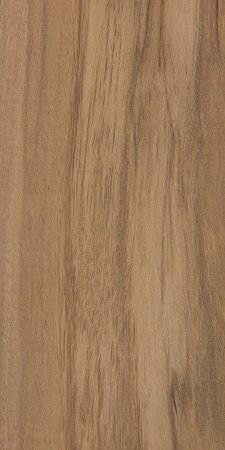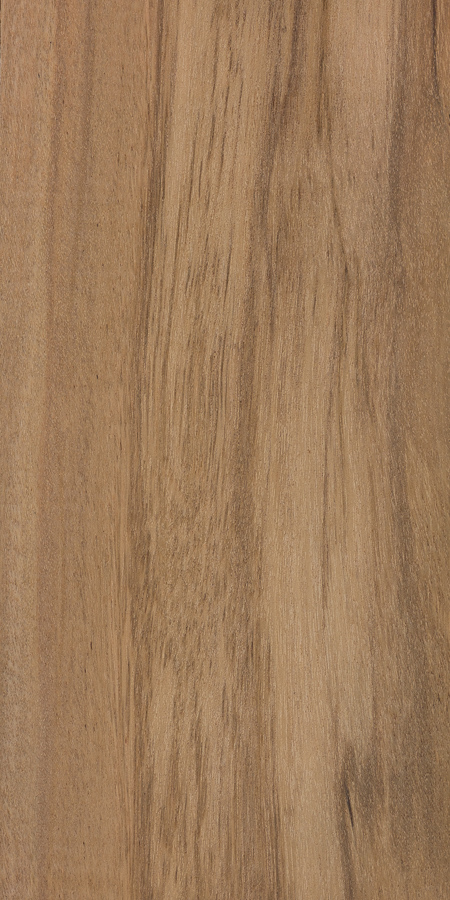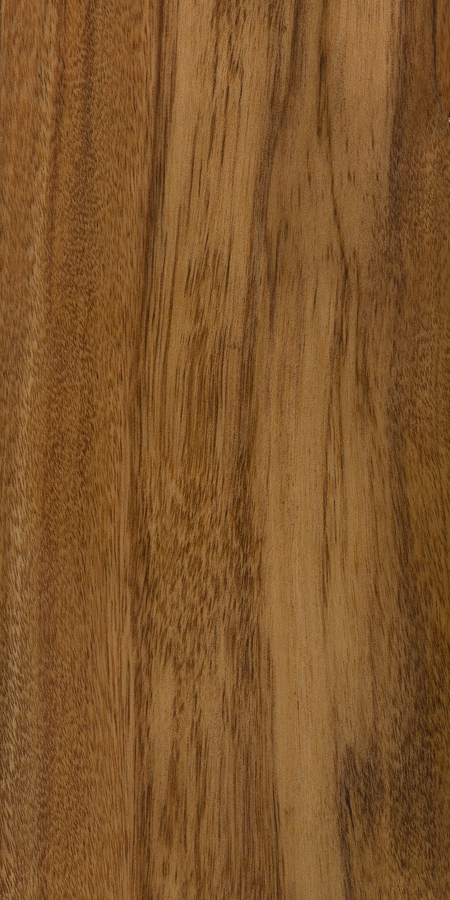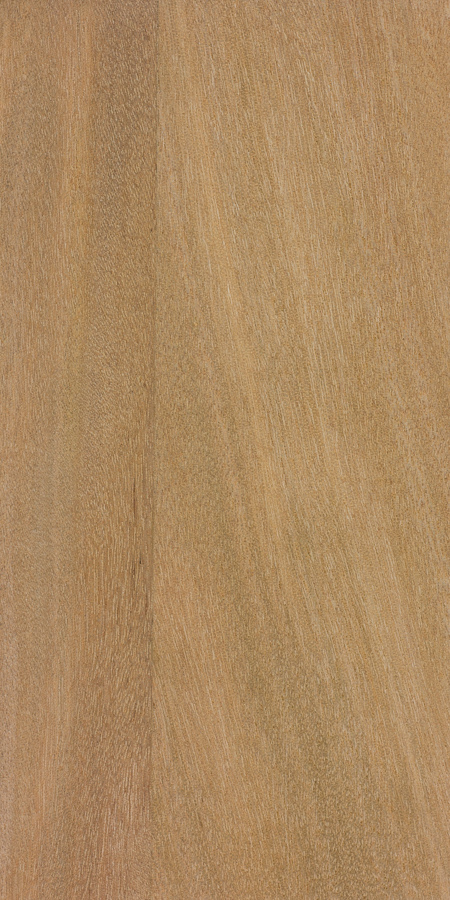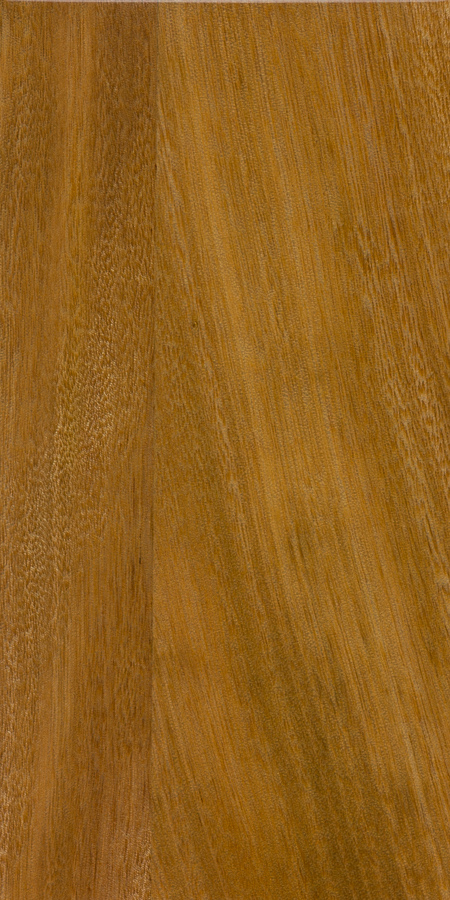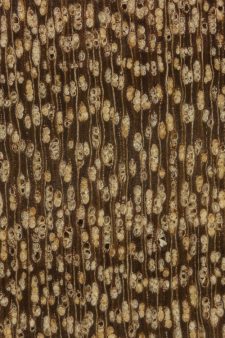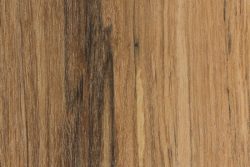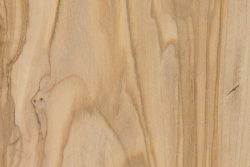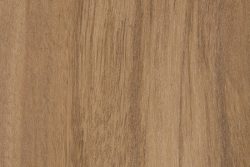DATA SOURCE(S): 6,15,36,43
Common Name(s): Elgon olive, loliondo, mushargi, Elgon teak
Scientific Name: Olea welwitschii
Distribution: Sub-Saharan Africa, south to Mozambique
Tree Size: 50-80 ft (15-25 m) tall,
1-2 ft (.3-.6 m) trunk diameter
Average Dried Weight: 48.0 lbs/ft3 (770 kg/m3)
Specific Gravity (Basic, 12% MC): .65,
Janka Hardness: 1,660 lbf (7,380 N)
Modulus of Rupture: 16,140 lbf/in2 (111.3 MPa)
Elastic Modulus: 1,568,000 lbf/in2 (10.81 GPa)
Crushing Strength: 10,230 lbf/in2 (70.5 MPa)
Shrinkage: Radial: ~2%, Tangential: ~4%,
Volumetric: ~6%, T/R Ratio: ~2
Color/Appearance: Heartwood is typically yellow to light reddish brown, with contrasting darker brown to black streaks and veins. Yellowish sapwood is generally sharply demarcated from the heartwood, though it can be harder to tell apart if the heartwood lacks contrasting streaks. Overall color tends to deepen with age. Olive is sometimes figured with curly or wavy grain, burl, or wild grain.
Grain/Texture: Grain may be straight, interlocked, or wild. Fine uniform texture with moderate natural luster. Slightly oily to the touch.
Rot Resistance: Rated as moderately durable to durable. Mixed insect/borer resistance.
Workability: Somewhat easy to work, though wild or interlocked grain may result in tearout during surfacing operations. Elgon olive tends to have slightly better stability than other Olea species, though it still experiences a fair degree of movement in service. Turns, carves, and finishes well.
Odor: Has a distinct, fruity scent when being worked.
Allergies/Toxicity: Although severe reactions are quite uncommon, olive has been reported as a sensitizer. Usually most common reactions simply include eye and skin irritation. See the articles Wood Allergies and Toxicity and Wood Dust Safety for more information.
Pricing/Availability: Typically only available as veneer or smaller craft blanks, natural-edged slabs and smaller boards are occasionally available. Expect prices to be high for an imported hardwood.
Sustainability: This wood species is not listed in the CITES Appendices or on the IUCN Red List of Threatened Species.
Common Uses: High-end furniture, veneer, turned objects, and small specialty wood items.
Comments: Named for the region of Mount Elgon bordering Uganda and Kenya, the tree is also called by the Swahili names mushargi and loliondo. Technically, all these names are also applied to East African olive (Olea capensis), and Elgon olive is sometimes considered to be a subspecies (listed as O. capensis ssp.welwitschii), though it is now generally recognized as a distinct species.[1]Green, P. S. (2002). A revision of Olea L.(Oleaceae). Kew Bulletin, 91-140. The specific epithet welwitschii is derived from 19th century Austrian botanist Friedrich Welwitsch—who is perhaps better known for discovering the bizarre, monotypic, CITES-listed plant Welwitschia.
Unlike the very minor differences in wood properties between the two primary species of commercial olive (Olea europaea and O. capensis), Elgon olive tends to be markedly lighter in weight (roughly 20% lighter, on average), and also more stable in service. However, it can also lack the contrasting streaks and veins that make olive wood so attractive. Accordingly, Elgon olive is also sometimes referred to as Elgon teak—though the wood is not botanically related to true teak (Tectona grandis).
Images: Drag the slider up/down to toggle between raw and finished wood. The first sample shows the characteristic striping found in most olive species, while the second is an example of a more bland and unfigured board.
Identification: See the article on Hardwood Anatomy for definitions of endgrain features.
Porosity: diffuse porous; growth rings generally not discernible
Arrangement: primarily in radial multiples of two to four
Vessels: medium, moderately numerous; yellowish brown deposits common
Parenchyma: vasicentric, though on most samples very little if any parenchyma is visible
Rays: narrow width, normal spacing
Lookalikes/Substitutes: With its dramatic contrasting streaks and veins, olive is sometimes confused with zebrawood (Microberlinia brazzavillensis). However, zebrawood has very large pores (giving the wood a coarse, open texture), as well as visible winged and banded parenchyma.
Notes: East African olive (Olea capensis) is a closely related species that is very similar to O. welwitschii. Generally, the wood is about 20% heavier and the pores may be slightly smaller in O. capensis.
Related Content:
References[+]
| ↑1 | Green, P. S. (2002). A revision of Olea L.(Oleaceae). Kew Bulletin, 91-140. |
|---|

